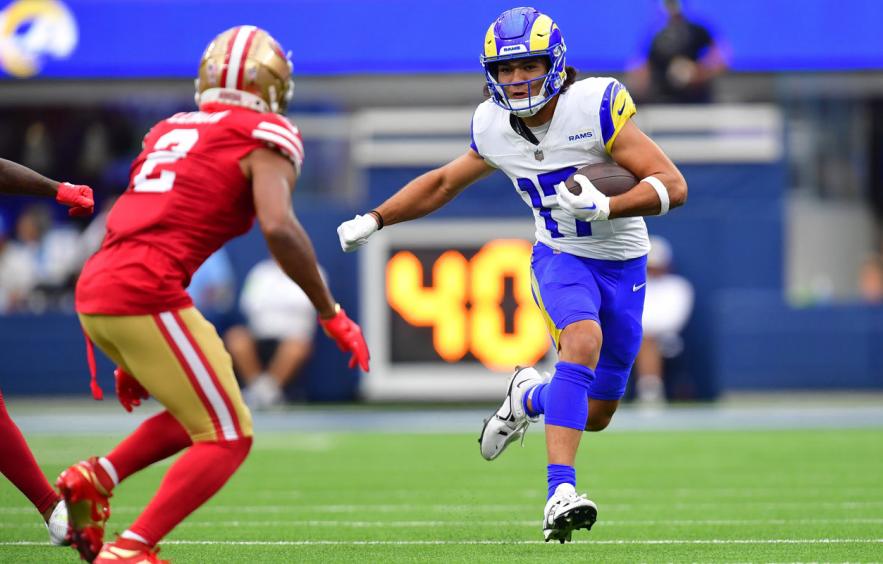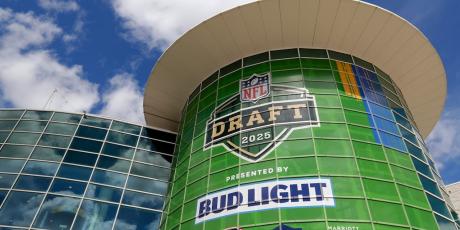Can DeAndre Hopkins Hold Off Father Time?

The fantasy football market is doing a better job of incorporating age-related risk into ADP. However, the market is applying that risk evenly to all aging players, rather than looking at a specific player’s talent and performance. This creates value opportunities for select older players who can break the general age cliff at their position. DeAndre Hopkins stands out as a particularly good target despite his age.
Click here for more 2024 Player Profiles!
Age and Contested Catch Concerns
A lot of the analysis around Hopkins this offseason brings up his contested catch rate. Hopkins only brought in 22.7% of his contested catches in 2023, which was his lowest rate since at least 2016. And that low contested catch rate has been used as evidence of Hopkins’ declining performance. However, when I looked at The Most Predictable Wide Receiver Stats, there was no correlation year-over-year for contested catch rates and no predictive power for future fantasy points. Using Hopkins as an example, he had a 31.3% contested catch rate in 2017 before nearly doubling that mark to 58.1% in 2018. You can safely ignore contested-catch-based analysis.
More concerning for Hopkins is that he’s entering his 12th NFL season. Most age cliff analysis shows the average WR’s performance dips sharply in Year 10. However, individual outcomes vary greatly from here. As Ryan Heath in his article Age Curves: When NFL Players Break Out and Fall Off put it: “Individual outcomes sharply diverge in Year 11, as players either remain relatively productive or fall to near-zero production – with few in between”. Let’s look at Hopkins’ Year 11, 2023 season to gauge his specific age risk.
Talent, Efficiency, and Volume
From a talent perspective, the most predictive variable I found was ESPN Analytics’ open score. This variable uses player-tracking data from NFL Next Gen Stats. For each route that a WR runs, an expected amount of separation is calculated by using historical data and the route, coverage, and depth of the particular play. A WR is then given an open score based on their separation relative to the benchmark. The score is standardized to range between zero and 99 where 50 is the league average. And Hopkins hit an open score of 82 in 2023, which was tied for the second-highest mark of his career.
With respect to efficiency, the two most predictive variables I found were yards per route run (YPRR) and first downs per route run (1DRR). Hopkins cleared the elite benchmarks we care about for both variables with 2.09 YPRR and 9.5% 1DRR in 2023.
Finally, from a volume standpoint, Hopkins cleared the 60-yard benchmark that has correlated with excellent future fantasy seasons. He averaged 62.2 receiving yards per game in 2023. Yet, that is a big decline from his 2022 season when he earned 79.9 yards per game with the Cardinals. I’d argue that is more telling of the Titans’ team-specific situation, given that Hopkins still finished 12th among WRs in targets per route run (TPRR) with 26.3%.
So, Hopkins’ open score, YPRR, and TPRR all improved in 2023. None of these factors indicate an immediate performance drop due to age. But, his per-game volume stats declined. With that in mind, the biggest thing Hopkins needs is an offense that passes the ball more often. And that’s just what he should get in 2024.
Titans Offensive Outlook
The graph below shows pass rate over expected (PROE) on the x-axis and how much that PROE fluctuated on a weekly basis on the y-axis. And I’ve circled both the Titans and the Bengals. As you can see, the Titans were one of the six most run-heavy teams in the NFL last year and they were very consistent in that approach. Alternatively, the Bengals were second in PROE, finishing behind only the Chiefs and Patrick Mahomes. Signing the Bengals’ offensive coordinator, moving on from Derrick Henry, and giving Calvin Ridley a massive contract, all point in one direction: The Titans are going to pass the ball more in 2024.
Hopkins had the 14th highest aDoT among 107 qualifying WRs in 2023. And if you narrow that sample down to fantasy-relevant WRs, he was really only behind Mike Evans’ 15-yard aDoT. With that in mind, the graph below shows completion percentage over expectation (CPOE) on the x-axis and average air yards per attempt on the y-axis. Again, the Titans and Bengals occupy opposite corners of the graph. Will Levis wasn’t especially accurate in 2023 but at least wasn’t outlier-level bad. That level should be sufficient for Hopkins to put up WR2-type fantasy numbers.
What was an outlier was Levis’ air yards per attempt. On average, he threw the ball about two yards farther down the field than any other starting QB in the league. Meanwhile, both Joe Burrow and Jake Browning were in the bottom five in air yards per attempt. Given that this trend held for both Burrow and Browning, it seems likely that Brian Callahan’s system will bring Levis’ air yards per attempt down significantly in 2024. A lower aDoT could be a win for Hopkins if the Titans scheme him up some easier looks to boost his volume as we see with other aging WRs throughout the league.
Bottom Line
• DeAndre Hopkins had one of his best open scores in 2023 along with YPRR and 1DRR marks that clear the elite benchmarks.
• The main thing that stood in his way in 2023, where he finished WR25, was the passing volume of the Titans offense.
• But with the Titans moving on from Derrick Henry, signing Calvin Ridley, and hiring Brian Callahan, they are signaling the intent to pass a lot more in 2024.
• The age concerns are a real risk but they’re more than baked-in at his WR40 ADP. Hopkins is a target in any format when you can draft him as a WR4.
























